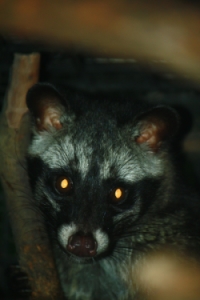
Photograph of one of the Singapore musangs.
December 1, 2009
In this day and age, you often read about wild animals trying to be kept out of urban areas. But, in Singapore, there is an active effort to save and preserve the urban presence of the common palm civet (also known as the “toddy cat” and “musang” in Malay, Paradoxurus hermaphroditus in Latin).

Photograph of one of the Singapore musangs.
Kumar Pillai writes,
Long nights of peering into darkness finally paid off on 15 November [2009] when a toddy cat was sighted in the Opera Estate area [in Singapore].
Night Safari has been conducting toddy cat surveys in the Siglap/Opera Estate area since [the] end [of] October [2009], in collaboration with the National University of Singapore. The toddy cat project, also known as musang in Malay is part of a conservation effort by the two organisations to resolve and mitigate human-toddy cat conflict reported in the neighborhood.
The first sighting of the toddy cat in the research area has bolstered the hopes of the team as it’s testament to the fact that toddy cats are still part of Singapore’s urban landscape.
* * *
“Through this project, we hope to raise the awareness of the plight of the Singapore toddy cats and make people realise that living among these creatures should be a cause of celebration instead of concern. That despite rapid urbanisation, we are still fortunate to have them as part of our natural heritage. We need everybody’s help to preserve them” said Mr Kumar Pillai, assistant director of zoology, Night Safari.
The team targets to complete the survey by January 2010. Thereafter, data gathered will be archived by the National University of Singapore’s Raffles Museum of Biodiversity Research for reference. Following which, Night Safari will be writing a paper on the model used to resolve the human/musang conflict which was adopted for the project. This is turn will be used to develop a five-year action plan for the conservation of one of the last remaining carnivores in Singapore – the toddy cat.
The toddy cat or musang is also known as the common palm civet. It averages 3.2kg, has a body length of 53cm and a tail length of 48cm. Its long, stocky body is covered with coarse, shaggy hair that is usually greyish in color, with black on its feet, ears and muzzle. It has three rows of black markings on its body. The markings on its face resemble a raccoon’s. Its tail does not have rings, unlike similar civet species. It is found in plantations and is reputed to reside in areas where there is human habitation….
For the rest of the article, which is about general habitat/survey info, see here.
About Loren Coleman
Loren Coleman is one of the world’s leading cryptozoologists, some say “the” leading living cryptozoologist. Certainly, he is acknowledged as the current living American researcher and writer who has most popularized cryptozoology in the late 20th and early 21st centuries.
Starting his fieldwork and investigations in 1960, after traveling and trekking extensively in pursuit of cryptozoological mysteries, Coleman began writing to share his experiences in 1969. An honorary member of Ivan T. Sanderson’s Society for the Investigation of the Unexplained in the 1970s, Coleman has been bestowed with similar honorary memberships of the North Idaho College Cryptozoology Club in 1983, and in subsequent years, that of the British Columbia Scientific Cryptozoology Club, CryptoSafari International, and other international organizations. He was also a Life Member and Benefactor of the International Society of Cryptozoology (now-defunct).
Loren Coleman’s daily blog, as a member of the Cryptomundo Team, served as an ongoing avenue of communication for the ever-growing body of cryptozoo news from 2005 through 2013. He returned as an infrequent contributor beginning Halloween week of 2015.
Coleman is the founder in 2003, and current director of the International Cryptozoology Museum in Portland, Maine.
Filed under Breaking News, CryptoZoo News, Weird Animal News